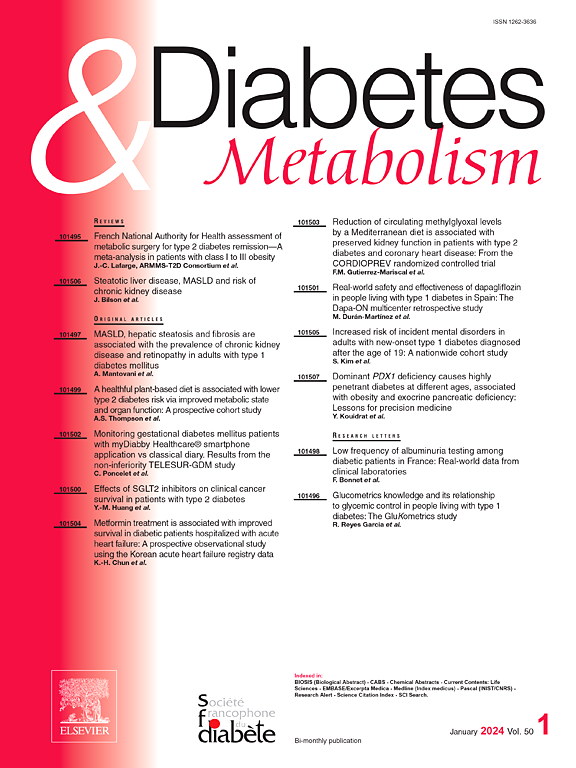1型和2型糖尿病的传导干扰在两个大型独立的全国和国际数据库。
IF 4.7
2区 医学
Q1 ENDOCRINOLOGY & METABOLISM
引用次数: 0
摘要
目的:1型(T1D)和2型糖尿病(T2D)与心血管风险增加相关,但关于它们与传导障碍的独立关联的数据有限。我们评估了糖尿病和传导障碍之间的关系,在两个独立的数据库中比较了T1D和T2D人群与非糖尿病对照组。方法:观察性研究,使用两个具有匹配队列的大型数据库:法国PMSI和国际TriNetX网络。PMSI捕获法国全国范围内的医院入院情况,而TriNetX包括来自全球120多个医疗机构的患者。我们从PMSI中发现了440,000例T2D患者,从TriNetX中发现了900,000例T2D患者和20,000例T1D患者。采用1:1倾向评分匹配,根据人口统计学和合并症将这些患者与非糖尿病对照进行匹配。结果:与非DM相比,T2D与传导障碍的风险较高相关,包括房室传导阻滞(HR 1.22 [1.19-1.25], PMSI;HR 1.50 [1.45-1.55], TriNetX),左束支阻滞(BBB), (HR 1.12 [1.08-1.17], PMSI;HR 1.50 [1.47-1.54], TriNetX),右BBB (HR 1.14 [1.09-1.18], PMSI;HR 1.38 [1.34-1.43], TriNetX)。t2dm患者发生心肌梗死的风险也较高(HR 1.29 [1.25-1.32], PMSI;hr2.14 [2.08-2.19];相反,在TriNetX队列中,T1D与传导障碍风险增加无关。结论:与非DM相比,T2D与传导障碍和更高的冠状动脉事件发生率独立相关,而T1D似乎不具有相同的风险。这表明不同的病理生理机制和可能需要加强监测的T2D患者。本文章由计算机程序翻译,如有差异,请以英文原文为准。
Conduction disturbances in Type 1 and Type 2 Diabetes in two large independent nationwide and international databases
Aim
Type 1 (T1D) and type 2 diabetes (T2D) are associated with increased cardiovascular risk, but limited data exist on their independent association with conduction disturbances. We evaluated the association between diabetes and conduction disorders, comparing T1D and T2D populations with non-diabetic controls in two independent databases.
Methods
Observational study using two large databases with matched cohorts: the French PMSI and the international TriNetX network. PMSI captures nationwide hospital admissions in France, while TriNetX includes patients from over 120 healthcare organizations worldwide. We identified > 440,000 patients with T2D from PMSI and > 900,000 patients with T2D and > 20,000 patients with T1D from TriNetX. Using 1:1 propensity score matching, these patients were matched to non-diabetic controls based on demographics and comorbidities
Results
Compared to no DM, T2D was associated with a higher risk of conduction disturbances, including atrioventricular block (HR 1.22 [1.19–1.25], PMSI; HR 1.50 [1.45–1.55], TriNetX), left bundle branch block (BBB), (HR 1.12 [1.08–1.17], PMSI; HR 1.50 [1.47–1.54], TriNetX), and right BBB (HR 1.14 [1.09–1.18], PMSI; HR 1.38 [1.34–1.43], TriNetX). Patients with T2D also had a higher risk of myocardial infarction (HR 1.29 [1.25–1.32], PMSI; HR 2.14 [2.08–2.19], TriNetX). Conversely, T1D was not associated with an increased risk of conduction disorders in the TriNetX cohort.
Conclusion
T2D is independently associated with conduction disturbances and a higher incidence of coronary events compared to no DM, whereas T1D does not appear to confer the same risk. This suggests distinct pathophysiological mechanisms and the possible need for enhanced monitoring in T2D patients.
求助全文
通过发布文献求助,成功后即可免费获取论文全文。
去求助
来源期刊

Diabetes & metabolism
医学-内分泌学与代谢
CiteScore
12.00
自引率
4.20%
发文量
86
审稿时长
13 days
期刊介绍:
A high quality scientific journal with an international readership
Official publication of the SFD, Diabetes & Metabolism, publishes high-quality papers by leading teams, forming a close link between hospital and research units. Diabetes & Metabolism is published in English language and is indexed in all major databases with its impact factor constantly progressing.
Diabetes & Metabolism contains original articles, short reports and comprehensive reviews.
 求助内容:
求助内容: 应助结果提醒方式:
应助结果提醒方式:


